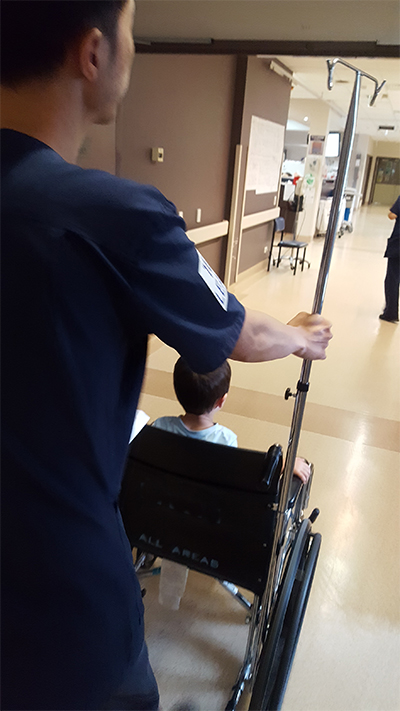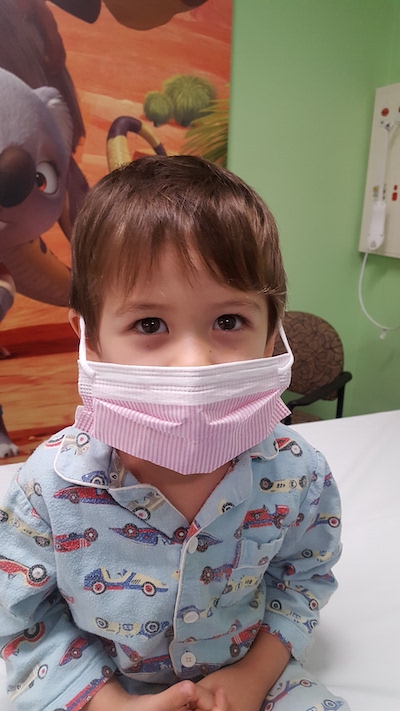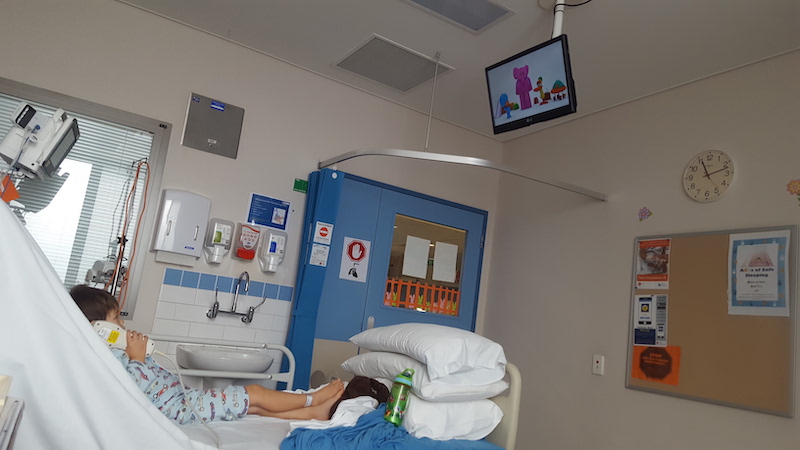How the pandemic affected my son’s trip to the hospital’s emergency department.
My husband and I brought our son to our local hospital’s emergency department last week. “Rushed to emergency” may be a term used more frequently, but just so I don’t make this sound as alarming as it may seem, I’m saying we simply “brought” him to emergency because the situation wasn’t quite that dire.
We were, however, still being concerned and responsible parents, and following his asthma action plan, which advised us to go to emergency if three-year-old Elliott required salbutamol (street name: Ventolin) less than three hours apart. At that point, we were at one hour apart, but other than an increasing rate of dry asthma cough, Elliott was still, well, Elliott—no lethargy, no blue lips.
We weren’t terribly panicked, especially as we had done the entire drill only three weeks earlier (Elliott had to be hospitalised overnight for observations then, but once again, everybody was simply alert, not alarmed).
Now to be clear. Elliott hasn’t been diagnosed with asthma because he’s too young to go through the vigorous tests to be labelled as “asthmatic”. Instead, he has what the doctors call “viral-induced wheeze”, which for all intents and purposes, is an asthmatic attack triggered by a cold or flu. It’s something that presented itself when he was just over a year old (after our very first visit to emergency) and has occurred fairly often throughout his young life (toddlers, after all, have eight to 10 colds a year)—although up to this year, we’ve always managed to keep his attacks under control at home.
Having, as I mentioned, gone through the same experience less than a month ago, I thought I knew what to expect with this most recent visit to emergency. Little did I realise just how much COVID-19 would have changed practices at healthcare facilities—and would appear to continue to do so on a daily basis.
Because Elliott presented to emergency with what they termed a “respiratory symptom”, everybody was put on high alert for potential COVID-19 infection. This meant that while he was simply placed in a wheelchair and transported to a paediatric bed on the first visit, he was asked to put on a mask as a precautionary measure this time. (He was, however, provided with an adult-sized mask, which made his little face look even tinier and suddenly really vulnerable. It also didn’t stay on his face very well.)


At our own little corner of the paediatric section of emergency, the doctor informed us that a new procedure was introduced that day for anybody admitted with respiratory symptoms: Double nasal swabs to test for COVID-19 and some other viruses (I don’t know what, because needless to say, I stopped listening when she said “test for COVID-19”).
“Now we know it’s very likely just an asthma attack, but unfortunately, with all the fears going around, it’s what we have to do,” she further explained. “So we’re going ahead with what we’ll do for asthma, but we’ll need to do the tests as well.”
“No worries, I understand,” I replied, trying to lighten the mood. “We’ll just go out and buy a bunch of toilet paper after we’re discharged.”
You’ll know the drill if your child has ever been in hospital due to an asthma attack. They’ll give them a dose of prednisolone and proceed to pump salbutamol into them at regular intervals, stretching it out as time goes by. Elliott’s was delivered via a spacer and mask due to his age.
That was the plan of attack for Elliott that night with two (rather long) differences: Nasal swabs that go through the nostrils until they reach the back of the throat. Since Elliott did not know what to expect, the poor little darling took the first test extremely well. The nurse managed to put the swab all the way in and pull it out with him staying absolutely still.
Two seconds later, however, I saw tears form in his eyes, followed promptly by a heart-wrenching wail.
“Mummy, no! It hurts!” he yelled.
There was nothing I could say to console him, since he was crying, screaming and thrashing about so loudly. Both my husband and I had to hold him down so that the nurse could repeat the test in Elliott’s other nostril. Elliott fought the good fight, throwing his head left and right, doing his best to avoid the super-long cotton bud. I could only hope that as I held him still, that he also felt my love and pain—and not just that I was restraining him.
Elliott calmed down a few minutes later (although the experience was clearly not forgotten, as he talked to my husband about it the next evening) and we proceeded with the routine recovery procedure for an asthma attack.
After being in emergency for around two hours, at around 11pm, the doctor confirmed Elliott would be admitted overnight for observations and to continue with his by then two-hourly salbutamol doses.
“Because he’s admitted for a respiratory issue and because of COVID-19 fears, he’ll be placed in isolation,” the doctor warned.
Yay for a private room!
Am I a bad person if I admitted that was the only thought that ran through my mind when she said that? (We were in a shared room during our previous admission.)
We decided that I would stay with Elliott for the night and take the next day off work, while my husband would go home and go to work the next day.
It may be interesting to point out that up until that point, despite the COVID-19 fears, only some of the doctors and nurses who came to tend to Elliott wore masks or gloves, but they all dutifully washed their hands when they were done. Also, nobody sprayed anti-bacterial spray in my husband’s general direction, much less spoke to him, when he left.
But not long after my husband left, I heard rustling just behind the drawn curtain. I knew somebody was organising something behind the curtains, but unlike the other nurses who had been in to tend to Elliott, this person was taking a really long time.
Finally, the curtains were drawn back with a flourish, and a man appeared, decked out like someone from the movie Contagion. He wasn’t in a full hazmat suit, but he was wearing a long flimsy plastic gown, a mask and surgical gloves. And he wanted my signature on a few sheets of paper to finalise Elliott’s admission into hospital. Five seconds later, signatures obtained, and he was back behind the curtains rustling again—presumably taking off his protective gear.
It took him longer to put on and remove his protective gear than it did for me to sign the three sheets of paper. He could have slipped the clipboard to me from under the curtain to save him all the hassle.
Next up, a nurse appeared, sans protective gear, to move us to the ward. She instructed me to place the adult-sized mask on the now-asleep Elliott before carrying him to our accommodation for the night. Unfortunately, between heaving a 16-kilo sleeping preschooler in front of me and a backpack behind me, I lost track of the mask somewhere during our 200-metre walk.
Relevant: Talking to your children about COVID-19
As guessed, we were placed in a private room. Thankfully, Elliott stirred but didn’t wake during the transfer and a while later, as I was preparing to settle in for the night, a different nurse walked in, fully dressed in gown, mask and gloves.
“I’m here to give Elliott his next dose of salbutamol,” he told me.
As mentioned, we had gone through the same routine just three weeks earlier. And back then, the nurses would casually come in (with no protective gear) and quietly give Elliott the required doses while he was still sleeping. Elliott would wake up, but once he knew I was nearby and held my hand, either calmed down or fell back asleep. That was then.
This time—and every two hours for the entire night—Elliott would wake up and scream and cry, and fight any attempt to dispense salbutamol into him. No amount of “Mummy’s here” or hand-holding made a difference because I could see the fear in his eyes, which were firmly fixed on a blurry face in the dimly-lit room, half-obscured by a mask.
Salbutamol finally dispensed, the nurses would then remove all protective gear, throwing the items into the bin just by the door in our room, and leave.
The next day, anybody who came into our room had to spend minutes putting on and taking off protective gear, including the poor people bringing us our meals and removing the used trays (the hospital provided me with meals as well since I wasn’t allowed out of the room either). Via text, I joked to my husband that the hospital would have been better off if they had installed a flap in the door so they could slide the food trays in and out, prison-style.
When the lady taking our lunch order tried to walk into our room without protective gear, she was sternly spoken to by a nurse. We reached a happy compromise where she stood a few steps out in the hallway while I stood by the door, shouting at her what I wanted.
In the midst of all of this, Elliott was having the time of his life. During our previous stay, we at least had the luxury of the paediatric ward’s playroom with new toys (to him) a plenty, and the hospital hallway to pace up and down. This time, being placed in isolation, we weren’t allowed to leave the room.
Confined to a three-metre by three-metre hospital room with one toy car and one book which we brought from home, the only way to capture a three-year-old’s attention was the TV. He was binge-watching Play School, Giggle and Hoot and various children’s shows on ABC KIDS like never before. And I mean that quite literally, since I’m fairly certain he doesn’t even know the TV at home works. Thankfully, I’ve once spoken to a digital expert who told me screen time isn’t all that bad.

Finally, at around 4pm, we were given the all clear and told we could go home. But that was only for his asthma. As the results of his COVID-19 test weren’t back, we were told Elliott (not us) needed to self-isolate until the results came back, “probably Monday”. It was Friday then. We still had a few long days ahead of us, even though Elliott was fully recovered on the asthma front.
When my husband came to bring us home, he didn’t have to go through any inspections or put on any protective gear to see us, and we didn’t have to undergo any further checks before we left either. After all that I had seen that day, it almost felt like we were breaking the law somehow.
Back home, we had to explain to our child why he couldn’t go out and play with his friends and figure out a way to entertain a three-year-old who’s used to playing outdoors, inside.
At the hospital, I asked different doctors and nurses how long it would take to receive the results for the COVID-19 test and received different answers. Nobody was certain, but estimates ranged from 24 hours to four days.
Hopeful I could go to work and Elliott to daycare, I rang the hospital first thing Monday morning for results.
“Call back tomorrow,” was the reply.
While we were fairly certain Elliott did not have COVID-19, we also didn’t want to be those people who sent their child to daycare and later have the test results come back positive, and so, we had another great day of mother-son bonding.
Thankfully, at 4pm that day, another phone call to the hospital confirmed Elliott’s COVID-19 test results had come back negative, and we were in the clear.
“So we can go out and do whatever we want now?” I couldn’t help but blurt out to the doctor on the phone.
“In a manner of speaking, yes?” came the rather hesitant reply.
And so as I write this, our lives are back to normal, or as normal as it can get for a nation preparing itself for a potential pandemic [Update: On March 11, The World Health Organization has declared COVID-19 a pandemic]. We haven’t thrown caution to the wind and doing “whatever we want” simply means I’m back at work and my son is back exploring the world and playing with his best friend (who lives upstairs) . . . until his next asthma attack.
I have written this not to criticise the level of care we received at the hospital, which was top-notch. Neither am I trying to mock the precautions being taken to prevent further spread of COVID-19 within the community. But I think it’s important to realise that all of us—even healthcare professionals and those making procedural decisions—are struggling to make sense of a situation that changes by the minute and are doing our very best to make the right decisions to keep all of us safe and sane.
The Australian Department of Health has a very good website that provides reliable up-to-date information on the COVID-19 situation.
How helpful was this article?
Click on a star to rate it!
5 / 5. 2
Be the first to rate this post!
Melody Tan
Related posts
Subscribe
Receive personalised articles from experts and wellness inspiration weekly!


